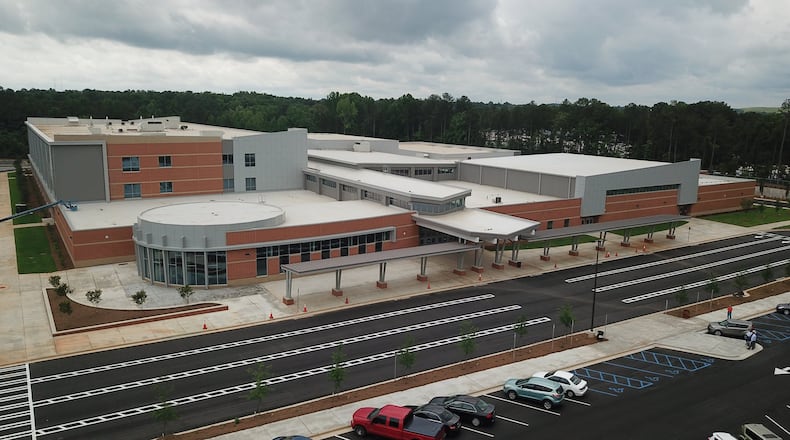New school construction has evolved well beyond the one-room structure of a century ago, and Gwinnett County’s newest high school illustrates just how far.
Modern school buildings take into consideration contingencies for weather, fire, intruders or various catastrophies, and instruction has become more sophisticated and more reliant on technology.
Gwinnett County’s newest high school, Paul Duke STEM, reflects all that. Part of the Norcross cluster, the school’s main function is to alleviate overcrowding at Norcross High. Last year Norcoss was about 1,000 students over capacity. But this school has an emphasis on particular studies, in science, technology, mathematics and engineering.
“In creating Paul Duke STEM, we were looking to provide a choice for students with a different interest,” said Steve Flynt, associate superintendent in charge of school improvement and operations. He added that the goal wasn’t to make Paul Duke better than the Norcross High. It was to add opportunities.
The school was purposely not conceived as a magnet or charter school, which can draw students from across attendance zones in the district, said Flynt.
The vision for Paul Duke was to focus on students already in the cluster, which is an attendance zone which maintains the same set of students from elementary through high schools. The school may open up enrollment to other students in the future, but that won’t be determined this year.
There are some differences in the two high schools offerings other than speciality classes. Norcross has Georgia High School Association sports and a marching band. Paul Duke has a gym, but it won’t accommodate interschool sports. It will also have a music room, and more for fine arts.
Principal Jonathon Wetherington said students should focus on what the school has to offer and not what it doesn’t.
“From the first day forward, students will have the opportunity to engage with faculty that will really encourage them on their academic journey to lay the foundation for success,” he said.
So far about 650 students in the cluster have chosen the new school, which has the capacity for 1,500. There are no seniors this year — just freshmen, sophomores and juniors. As the juniors become seniors, and word spreads about Paul Duke, the school should be full.
Paul Duke cost nearly $38 million, paid mostly for with ESPLOST funds. At 296,565 square feet, which would be about the size of three average Home Depot stores, it’s the smallest high school built in the last decade, but the most expensive per square foot, at $127.35.
The district’s Discovery High School cost the most in total — it was completed in 2015 at a price tag of over $70 million — but it cost $110.88 per square foot. Gwinnett School of Mathematics Science and Technology, which was built in 2009, is about 50,000 square feet larger and cost $99.88 per sqare foot.
Flynt said the rising cost of construction materials, labor and the competition in the market have dictated a higher price tag.
Richard L. Porter, director of the new Master of Real Estate Development program in the School of Building Construction at Georgia Institution of Technology, said he isn’t surprised that the cost has risen sharply in just a few years.
“Even though it’s a public project, it’s still competing with other local real estate development,” he said.
But if you look at how Gwinnett County has projected where and when it will need new schools, the design and placement of Paul Duke makes sense, Porter said.
Back in the 1950s throughout the country, public school systems were entering a suburban movement. The public school culture wanted relatively small neighborhood schools, tucked away from main roads and away from commercial development.
As Gwinnett County grew, it saw that urbanized districts were having problems coping with population shift. Schools became vacant. Since they weren’t in areas desirable for new development, many still sit vacant.
Gwinnett’s model in the 1990s, up until Paul Duke, took advantage of large suburban growth, and design standards changed to create larger schools. For example, Archer High School, completed in 2009, has 120 classrooms. Paul Duke has 80.
Now, instead of trying to stay ahead of growth by building bigger schools, districts across the country are having to consider other issues, such as safety, said Porter. There's more thought going into the points of entry, moving students through the building, safe spaces and bullet-resistant glass.
“The design of Paul Duke is somewhat avant-garde,” said Porter. “It’s encompassing security, sociology and technology.”
The security aspect is evident when you drive up to the school. All traffic is guided in one direction. Many of the labs have windows where walls would be in traditional schools. That way the teacher can monitor activity of several classes at a time.
On the social front, schools are being designed for the use of intimate spaces that improve engagement and encourage collaboration are the next phase of school design, he added. For instance, instead of one huge lecture area, there are three at Paul Duke that hold fewer than 100 people.
“With a large population, large schools will find it harder to engage students and community,” he said.
And with career opportunities in fields such as cyber security, technology is a must. Instead of retrofitting a building for more efficient energy usage or high-speed data processing, those components were part of the design.
Gwinnett County has two more high schools in the design and construction phases for 2019 and 2020.
“We’re constantly assessing needs, and since it takes several years for a new school to come online, our projects can be as much as 10 years out,” said Flynt. “The cluster concept has worked well. We don’t have any empty schools.”
Who was Paul Duke?
Where others saw nothing but a scruffy piece of land and a smattering of pine trees, Paul Duke saw a gleaming vision of the future. In the late 1960s, he dreamed of a new type of suburb in Gwinnett County. The real estate developer founded company called Peachtree Corners, and the planned community of the same name, according to a 2003 obit in the AJC.
As the “Father of Peachtree Corners,” as he came to be known, Duke looked past the absence of telephone poles, sewer or power lines and envisioned a way of life decades ahead of its time.
“It’s a little ironic that a school is named after my dad, because he wasn’t the best scholar,” said Fraser Duke. “But it is fitting that something devoted to technology in that part of metro Atlanta has his name on it.”
Although the senior Duke earned bachelor’s degrees in mechanical and industrial engineering from Georgia Tech, his passion was in real estate development, said his son.
“He used to call Gwinnett County ‘God’s Country,’” he said.
The obituary went on to say that Duke was an All-American center under legendary Tech football coach Bobby Dodd. And after he graduated, Duke played professionally for a year with the now-defunct New York Yankees football club.
Duke spent eight years at Atlantic Steel Co., then three decades helping to reshape the landscape of Gwinnett County. He played a major role in organizing Technology Park Atlanta Inc. and took part in numerous civic activities.
“We learned a few years ago that the school district wanted to name the new school after my dad,” said Duke. “I think he would have been pleased.”
About the Author
Keep Reading
The Latest
Featured



